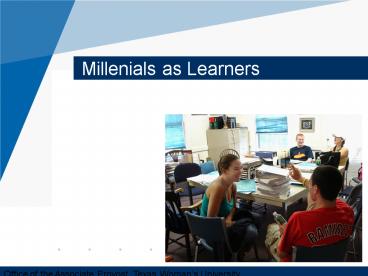Millenials as Learners - PowerPoint PPT Presentation
1 / 17
Title:
Millenials as Learners
Description:
Office of the Associate Provost, Texas Woman's University ... Office of the Associate Provost, Texas Woman's University. They are intolerant of delays ... – PowerPoint PPT presentation
Number of Views:72
Avg rating:3.0/5.0
Title: Millenials as Learners
1
Millenials as Learners
2
Critical Characteristics that Impact Learning
- They are Special
- They are sheltered
- They are team-oriented
- They are achievers
3
- They are conventional
- They live in a world of technology
- They multitask as a way of life
- Inter-connectedness is a way of life
4
- They are intolerant of delays
- They learn by doing and find no value in
accumulating facts - Reality is not necessarily real and ownership
is not necessarily digitally understood
5
Think - Pair - Share
- Think about these characteristics for 60 seconds
- Pair up with a partner
- Share your reflections
- Report back to the group
6
What this means for faculty
- Developing learning experiences students can
personalize. - Using knowledge-sharing among students as a major
source of content and pedagogy. - Infusing case-based participatory simulations
into traditional instruction - Evaluating collaborative, non-linear work
products and using student formative feedback on
faculty effectiveness - Chris Dede Planning for Neomillenial Learning
Styles, Educause Review, 2005.
7
LEARNING is
- about making and maintaining connections
- Expose students to alternative worldviews and
culturally diverse perspectives. - Give students responsibility for solving problems
and resolving conflicts. - Make explicit the relationships among parts of
the curriculum and between the curriculum and
other aspects of the collegiate experience. - Deliberately personalize interventions
appropriate to individual circumstances and
needs.
8
LEARNING is
- is enhanced by taking place in the context of a
compelling situation that balances challenge and
opportunity - Articulate and enforce high standards of student
behavior inside and outside the classroom. - Give students increasing responsibility for
leadership. - Create environments and schedules that encourage
intensive activity as well as opportunities for
quiet deliberation. - Establish internships, externships, service
learning, study abroad, and workplace-based
learning experiences.
9
LEARNING is
- an active search for meaning by the learner
- Expect and demand student participation in
activities in and beyond the classroom. - Design projects and endeavors through which
students apply their knowledge and skills. - Build programs that feature extended and
increasingly challenging opportunities for growth
and development.
10
LEARNING is
- developmental, a cumulative process involving the
whole person - Design educational programs to build
progressively on each experience. - Track student development through portfolios that
document levels of competence achieved and
intentional activities leading to personal
development. - Establish arenas for student-faculty interaction
in social and community settings. - Present opportunities for discussion and
reflection on the meaning of all collegiate
experiences.
11
LEARNING is
- done by individuals who are intrinsically tied to
others as social beings - Strive to develop a campus culture where students
learn to help each other. - Establish peer tutoring and student and faculty
mentorship programs. - Sponsor residence hall and commuting programs
that cultivate student and faculty interaction
for social and educational purposes. - Support activities that enable students from
different cultural backgrounds to experience each
others traditions.
12
LEARNING is
- strongly affected by the educational climate in
which it takes place - Build a strong sense of community among all
institutional constituencies - Organize ceremonies to honor/highlight
contributions to community life and educational
values.Publicly celebrate institutional values. - Articulate how each administrative and academic
unit serves the institutions mission.
13
LEARNING is
- grounded in particular contexts and individual
experiences, requiring effort to transfer
specific knowledge and skills to other
circumstances or to more general understandings
and to unlearn personal views and approaches when
confronted by new information - Sponsor events that involve students with new
people and situations. - Champion occasions for interdisciplinary
discourse on salient issues. - Foster dialogue between people with disparate
perspectives and backgrounds.
14
LEARNING requires
- frequent feedback if it is to be sustained,
practice if it is to be nourished, and
opportunities to use what has been learned. - Recruit students with relevant academic interests
as active participants and leaders in related
campus life programs and activities. - Organize work opportunities to take advantage of
students developing skills and knowledge. - Collaborate with businesses and community
organizations to match students to internship and
externship experiences that fit their evolving
educational profiles. - Develop student research and design projects
based on actual problems or cases presented by
external organizations to be resolved.
15
LEARNING takes place
- Both formally and informally beyond explicit
teaching or the classroom - Sponsor programs for students, faculty, and staff
that serve both social and educational purposes. - Organize community service and service-learning
activities performed by faculty, staff, and
students together.Design campus life programs
that relate directly to specific courses. - Link students with peers and with faculty, staff,
and community mentors. - Build common gathering places for students,
faculty, and staff.
16
LEARNING requires
- to monitor their own learning, to understand how
knowledge is acquired, to develop strategies for
learning based on discerning their capacities and
limitations, and to be aware of their own ways of
knowing - Help students delineate and articulate their
learning interests, strengths, and deficiencies. - Reduce the risk to students of acknowledging
their own limitations. - Help students select curricular and other
educational experiences covering a broad range of
learning approaches and performance evaluations.
17
Teaching Methods That Support Student Learning
- Involvement
- Role modeling
- Integration of in-class out-of-class
experiences - Intervention through counseling and advising
- Optimum dissonance
- Create high expectations in academics and adult
role expectations - Sense of community and campus involvement
- Direct instruction
- Group participation
- Leadership experience
- Milieu management
- Structuring the peer environment
- Direct feedback and support































